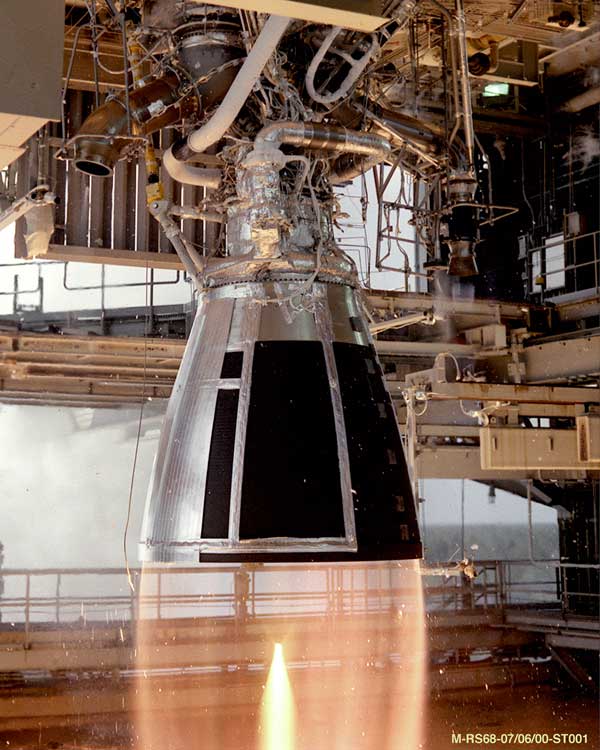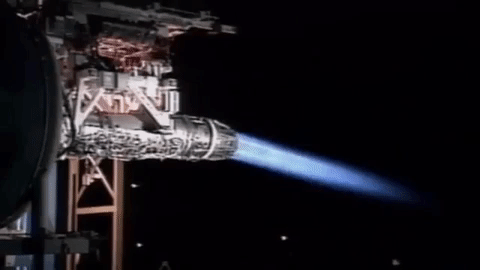|
TH-12
The TH-12 (, lit. ''Sky Fire 12'') is an oxidizer-rich gas-generator cycle rocket engine burning LOX and kerosene under development by Space Pioneer. The TH-12 utilizes 3D printing and has the highest target thrust among all commercial rocket engines in China. The engine features deep throttling for reusability, re-ignition, thrust vectoring, and multi-mode starters. History Space Pioneer proposed the TH-12 engine for its Tianlong-3 Tianlong-3 (, ''TL-3'') is a medium-lift orbital launch vehicle developed by the Chinese private aerospace manufacturer Space Pioneer. It is designed to be partially reusable, with the first stage capable of performing an autonomous vertical landi ... launch vehicle. Engine development was underway in December 2020, with the first gas generator test performed in September 2022. In November 2022, a full-stage developmental TH-12 engine successfully completed its first static fire test. On July 24, 2023, the TH-12 engine, in the flight configuration ... [...More Info...] [...Related Items...] OR: [Wikipedia] [Google] [Baidu] |
Tianlong-3
Tianlong-3 (, ''TL-3'') is a medium-lift orbital launch vehicle developed by the Chinese private aerospace manufacturer Space Pioneer. It is designed to be partially reusable, with the first stage capable of performing an autonomous vertical landing and being reused up to 10 times. Tianlong-3 is part of Space Pioneer's efforts to develop low-cost, reusable launch vehicles to compete in the growing commercial launch market. It aims to provide launch services for medium-sized payloads to low Earth orbit (LEO) and sun-synchronous orbit (SSO). Design First stage The first stage of the Tianlong-3 is equipped with 9 Tianhuo-12 (TH-12) liquid oxygen/kerosene engines. Each engine has a vacuum thrust of 1,350 kN, a vacuum specific impulse of 335 s, a sea-level thrust of 1,090 kN, a sea-level specific impulse of 285 s, a throttling range of 40%~110%, and a thrust-to-weight ratio of 163. The engines utilize a gas generator cycle and feature pump-fed gimbaling. The first stage ... [...More Info...] [...Related Items...] OR: [Wikipedia] [Google] [Baidu] |
Space Pioneer
Space Pioneer (), also known as Beijing Tianbing Technology Co., Ltd., is a Chinese aerospace company developing reusable orbital rocket technology—both launch vehicles and liquid rocket engines—to access the market for low-cost space launch services. The company is aiming to meet launch requirements for both the Chinese national satellite internet project and also the CNSA solicitation for resupply of the Tiangong space station. The stated mission of Space Pioneer is to "pursue new breakthroughs in technology and performance, ndto select a technological path based on the needs of the commercial market to improve launch efficiency and reduce launch costs." History Space Pioneer was founded in 2019 by Kang Yonglai. Kang was the former CTO of LandSpace until 2019, when he left to establish Space Pioneer. The company completed two funding rounds in 2019, including a ZJU Joint Innovation investment, to continue liquid bipropellant engine development of the Tianhuo serie ... [...More Info...] [...Related Items...] OR: [Wikipedia] [Google] [Baidu] |
China
China, officially the People's Republic of China (PRC), is a country in East Asia. With population of China, a population exceeding 1.4 billion, it is the list of countries by population (United Nations), second-most populous country after India, representing 17.4% of the world population. China spans the equivalent of five time zones and Borders of China, borders fourteen countries by land across an area of nearly , making it the list of countries and dependencies by area, third-largest country by land area. The country is divided into 33 Province-level divisions of China, province-level divisions: 22 provinces of China, provinces, 5 autonomous regions of China, autonomous regions, 4 direct-administered municipalities of China, municipalities, and 2 semi-autonomous special administrative regions. Beijing is the country's capital, while Shanghai is List of cities in China by population, its most populous city by urban area and largest financial center. Considered one of six ... [...More Info...] [...Related Items...] OR: [Wikipedia] [Google] [Baidu] |
RP-1
RP-1 (Rocket Propellant-1 or Refined Petroleum-1) and similar fuels like RG-1 and T-1 are highly refined kerosene formulations used as rocket fuel. Liquid-fueled rockets that use RP-1 as fuel are known as kerolox rockets. In their engines, RP-1 is Spray nozzle, atomized, mixed with liquid oxygen (LOX), and ignited to produce thrust. Developed in the 1950s, RP-1 is outwardly similar to other kerosene-based fuels like Jet A and JP-8 used in turbine engines but is manufactured to stricter standards. While RP-1 is widely used globally, the primary rocket kerosene formulations in Russia and other former Soviet countries are RG-1 and T-1, which have slightly higher densities. Compared to other rocket fuels, RP-1 provides several advantages with a few tradeoffs. Compared to liquid hydrogen, it offers a lower specific impulse, but can be stored at ambient temperatures, has a lower explosion risk, and although its specific energy is lower, its higher density results in greater energy de ... [...More Info...] [...Related Items...] OR: [Wikipedia] [Google] [Baidu] |
Gas-generator Cycle
The gas-generator cycle, also referred to as the GG cycle or colloquially as an open cycle, is one of the most commonly used power cycles in bipropellant liquid rocket engines. Propellant is burned in a gas generator (analogous to, but distinct from, a preburner in a staged combustion cycle) and the resulting hot gas is used to power the propellant pumps before being exhausted overboard and lost. Because of this loss, this type of engine is considered an open cycle (note other open cycles exist, e.g. the tap-off bleed cycle). The gas generator cycle exhaust products pass over the turbine's rotor(s) first. Then they are expelled overboard. They can be expelled directly from the turbine, or are sometimes expelled into the nozzle (downstream from the throat) for both a small gain in efficiency, and can serve as film cooling. An advantage of this cycle is the high pressure drop available to the turbine (GG chamber pressure down to ambient) for extracting work from the drive gas; at ... [...More Info...] [...Related Items...] OR: [Wikipedia] [Google] [Baidu] |
Rocket Engine
A rocket engine is a reaction engine, producing thrust in accordance with Newton's third law by ejecting reaction mass rearward, usually a high-speed Jet (fluid), jet of high-temperature gas produced by the combustion of rocket propellants stored inside the rocket. However, non-combusting forms such as cold gas thrusters and nuclear thermal rockets also exist. Rocket vehicles carry their own oxidiser, unlike most combustion engines, so rocket engines can be used in a vacuum, and they can achieve great speed, beyond escape velocity. Vehicles commonly propelled by rocket engines include missiles, Rocket-assisted projectile, artillery shells, ballistic missiles and rockets of any size, from tiny Rocket (firework), fireworks to Rocket (weapon), man-sized weapons to huge Space vehicle, spaceships. Compared to other types of jet engine, rocket engines are the lightest and have the highest thrust, but are the least propellant-efficient (they have the lowest specific impulse). The ideal ... [...More Info...] [...Related Items...] OR: [Wikipedia] [Google] [Baidu] |
Kerosene
Kerosene, or paraffin, is a combustibility, combustible hydrocarbon liquid which is derived from petroleum. It is widely used as a fuel in Aviation fuel, aviation as well as households. Its name derives from the Greek (''kērós'') meaning "wax"; it was registered as a trademark by Nova Scotian, Nova Scotia geologist and inventor Abraham Pineo Gesner, Abraham Gesner in 1854 before evolving into a generic trademark. It is sometimes spelled kerosine in scientific and industrial usage. Kerosene is widely used to power jet engines of aircraft (jet fuel), as well as some rocket engines in a highly refined form called RP-1. It is also commonly used as a cooking and lighting fuel, and for fire toys such as Poi (performance art)#Fire poi, poi. In parts of Asia, kerosene is sometimes used as fuel for small outboard motors or even motorcycles. World total kerosene consumption for all purposes is equivalent to about 5,500,000 barrels per day as of July 2023. The term "kerosene" is comm ... [...More Info...] [...Related Items...] OR: [Wikipedia] [Google] [Baidu] |
Thrust Vectoring
Thrust vectoring, also known as thrust vector control (TVC), is the ability of an aircraft, rocket or other vehicle to manipulate the direction of the thrust from its engine(s) or motor(s) to Aircraft flight control system, control the Spacecraft attitude control, attitude or angular velocity of the vehicle. In rocketry and ballistic missiles that fly outside the atmosphere, aerodynamic Flight control surfaces, control surfaces are ineffective, so thrust vectoring is the primary means of Flight dynamics (fixed-wing aircraft), attitude control. Exhaust vanes and Gimbaled thrust, gimbaled engines were used in the 1930s by Robert H. Goddard, Robert Goddard. For aircraft, the method was originally envisaged to provide upward vertical thrust as a means to give aircraft vertical (VTOL) or short (STOL) takeoff and landing ability. Subsequently, it was realized that using vectored thrust in combat situations enabled aircraft to perform various maneuvers not available to conventional-en ... [...More Info...] [...Related Items...] OR: [Wikipedia] [Google] [Baidu] |
Rocket Engines Of China
A rocket (from , and so named for its shape) is a vehicle that uses jet propulsion to accelerate without using any surrounding air. A rocket engine produces thrust by reaction to exhaust expelled at high speed. Rocket engines work entirely from propellant carried within the vehicle; therefore a rocket can fly in the vacuum of space. Rockets work more efficiently in a vacuum and incur a loss of thrust due to the opposing pressure of the atmosphere. Multistage rockets are capable of attaining escape velocity from Earth and therefore can achieve unlimited maximum altitude. Compared with airbreathing engines, rockets are lightweight and powerful and capable of generating large accelerations. To control their flight, rockets rely on momentum, airfoils, auxiliary reaction engines, gimballed thrust, momentum wheels, deflection of the exhaust stream, propellant flow, spin, or gravity. Rockets for military and recreational uses date back to at least 13th-century China. Significa ... [...More Info...] [...Related Items...] OR: [Wikipedia] [Google] [Baidu] |





